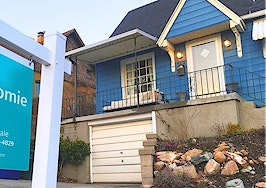For agents who want to boost their online marketing, virtual reality (VR) is no longer the most exciting tool on offer. It’s still effective, but live video is coming and in some ways works even better — especially when it comes to selling new houses or apartment developments.
After several years on the market, virtual reality still hasn’t attained anything near full adoption in real estate marketing. Mike DelPrete presented several reasons why in an Inman article last year.
VR still has a role to play, but some real estate agents feel it cuts them out of the marketing process. “Agents want prospective buyers to contact them, ask questions about a property and come to an open home. That’s how they get their leads!” wrote DelPrete.
While VR gives buyers more information about listings without having to talk to an agent, live video excels at putting the agent back into the center of the transaction.
Using live video to give and gather information
As an agent, the more information you have about buyers, the more power you have. You want to evaluate the buyers’ level of interest, their ability to close the transaction and their potential obstacles to doing so.
Buyers also want to know more. At my company, for example, our buyers are from China, and they are looking at property in the U.S. They have questions about what it’s like to live in your market, how their kids will like the local schools and what kind of neighbors they will have. VR can’t answer these questions. Only you, the agent, can.
Live video, also known as livestreaming or livecasting, serves the needs of both buyers and agents.
You may have heard about Lin Jingfu, the 58-year-old grandmother in remote China known as the “Hebei Rural Dama.” She spends at least 10 hours a day serving as a matchmaker for members of her audience while streaming herself on live video.
To date, she has brought together more than 200 couples and been instrumental in 30 marriages.
If a grandmother can use live video to unite two remotely located singles in marriage, then you can certainly use it to bring buyers together with your listings.
Think about listings pages, photos and virtual reality tours. These only allow one-way communication. You put them out there, and you hope they reach a buyer, but they aren’t part of a conversation.
Live video, on the other hand, is two-way communication. During live video, a buyer can ask about local zoning, the walk to the closest mass transit, the views from the back deck, nearby schools and commuting times — the list of potential topics is endless.
You never know where the conversation will go because your audience is also your co-director.
You might be surprised by how big your audience can grow. Research from eMarketer and UBS shows that 32 percent of 33- to 55-year-olds watch live video. In the younger demographic of 18- to 34-year-olds, the share that watches live video is twice as large at 64 percent.
How to make it work
So you can visualize how to use live video in your business, let me talk you through how Juwai.com deploys it. You can learn from our successes — and failures.
We have been using live video in real estate marketing for the past year. Here’s a hypothetical example showing how it works: Let’s say the goal of our example livecast is to market a new residential tower being built in Chicago.
Before the livecast, our team will work out a progression of topics and talent. They will also develop an audience via a marketing campaign on our website, in social media and on a number of partner platforms.
On the day of the live video, a representative may introduce the video and the topic before handing the floor to the agent who is selling the property. The agent will talk about the home, the market, yields and returns, the lifestyle and so on.
Then, the developer hands off to a lawyer or other local expert who can fill buyers in on their area of expertise. Because our buyers are mainland Chinese, we might also put on a Chicago resident who is originally from mainland China. That person can answer questions about living in the city, local schools, Chinese shops and neighborhoods and so on.
There might be 100, 200 or more buyers watching the live video. And here’s where it gets interactive: These buyers can ask questions.
They can ask the developer for something as simple as a demonstration of how smoothly the drawers close in the model apartment’s kitchen. Or they can ask the lawyer about something as complex as setting up an LLC to purchase the property.
Buyers get great value from this exchange of information, but so does the real estate agent. As an agent, you can have live conversations with real potential buyers. You get to hear their questions and gauge their reaction to the property. You can follow up afterward with the best prospects.
Another feature of live video is that it is never lost. Once the live event is over, the recording is kept online. This provides useful content for future buyers and can attract more to your next live video.
4 tips you shouldn’t overlook
If you plan on hosting your own live video, you can find some tips from other agents in this useful Inman article. You may also want to keep in mind these four important lessons that our team learned the hard way:
- The most successful content is multi-dimensional. If you can, include more than one speaker. Offer various perspectives and topics, so you can keep the audience’s interest and answer as many questions as possible.
- Don’t do a hard sell. Keep it informational and keep your focus on being useful. This always gets more consumer participation and better results.
- Test the signal at your location ahead of time. Even the most amazing live video will fail if you’re recording on your phone and your phone can’t get a signal.
- Remember that when working with overseas buyers, most of their questions will be about lifestyle, facilities, investment ROI, education, safety and visas. You may want to refresh yourself on related info before hitting the go-live button.













